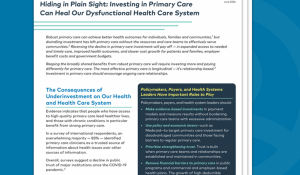You are looking at an archived version of our site. Please visit thepcc.org for a fresh, new experience!
You are here: Array » Tackling America’s M ...
Tackling America’s Mental Health and Addiction Crisis Through Primary Care Integration
Even before the COVID-19 pandemic, the unmet need for mental health and substance use services in the United States was significant. Alarmingly, less than half of adults with mental health conditions received services in 2019, and the percentage was even lower in Black and Latino communities. As for substance use, nearly 90% of people with a substance use disorder did not receive treatment.
That is why integrating primary and behavioral health care is necessary and would ensure that individuals with behavioral health conditions and comorbid physical health problems receive high-quality access to care. Comorbid behavioral and physical health diagnoses are common. Addressing them together through integration can provide a patient-centered approach that can be cost-effective for payers and providers, reduce health disparities, and improve patient outcomes.
Yet, the barriers to integration are substantial. As the COVID-19 pandemic has exacerbated behavioral health issues in our nation, so has it highlighted the problems inherent in our health care delivery system that make it difficult to respond.
To be sure, outcomes have worsened during the pandemic. Recent data indicate rising drug overdose deaths, worsening of existing mental health problems, and increasing incidence of anxiety and depression. Drug overdose death outpaced all previous records for a 12-month period, and symptoms of anxiety and/or depression in adults have quadrupled. A September 2020 study by Yale University School of Medicine found that those with a psychiatric diagnosis were at increased risk of death when they were hospitalized with COVID-19.
Critical to meeting America’s need for behavioral health services is increasing primary care provider capacity. Additional primary care providers would improve screening for mental health and substance use conditions, treatment delivery for mild to moderate behavioral health issues, and care coordination for patients who need more substantial services. While some primary care providers have already jumped in to do much of this work, many lack the training, financial resources, guidance, and staff to deliver integrated care. Recognizing the strong connection between physical and behavioral health, the Bipartisan Policy Center convened the Behavioral Health Integration Task Force in 2020, focused on breaking down barriers to integrating primary and behavioral health care. Research shows that integration enhances access to care, improves treatment outcomes, reduces health disparities, and is cost-effective.
BPC contracted with Health Management Associates (HMA) to assess many of the legislative and regulatory recommendations in this report for impact on the provision of care and on the projected cost or savings to the federal government. The results of these analyses are included alongside the recommendations in this report. The overall net cost to the federal government for those recommendations for which estimates were available totals $2.2 billion over ten years. That includes $6.9 billion in increased federal spending and $4.7 billion in savings. An estimated 1 million people would benefit from these recommendations.
The need to use all tools and policy levers to further integrate services is urgent given the national rise in behavioral health conditions and the persistent gaps in treatment. Behavioral comorbidities can lead to medical costs for physical conditions that are two to three times higher than those without behavioral health conditions, supporting the need for integrated care. Several states are already moving toward integration and demonstrating positive results. Illinois, Missouri, Arizona, Colorado, and Washington lowered medical costs by integrating care, primarily through their Medicaid programs. Arizona estimated health care savings of up to $14.4 million in its Medicaid managed care organization (MCO) contracts over two years,11 and Colorado saved an estimated $178.6 million12 from 2016-17 across public and private payers. These savings have often been accompanied by significant improvements in health outcomes for patients, such as increased access to care, reduced hospitalizations, and improved management of diabetes and hypertension.
Still, the nation’s current health care system does not adequately support the integration of primary and behavioral health care services. The task force’s recommendations create strong incentives for integration, while requiring accountability of providers. Together, these recommendations constitute a comprehensive plan to promote integration. Through developing core integrated care standards and, by ensuring the appropriate financing, tools, and training, these recommendations support and incentivize providers to deliver integrated care, which ultimately benefits Americans struggling with mental illness and substance use.
BPC’s recommendations provide a clear pathway to integration within both existing and new value-based payment structures. They improve the ability of primary care clinicians to handle some behavioral health needs of their patients by providing enhanced payments, training, and technical assistance, and improving access to behavioral health providers for consultation and referral. In order to expand the current workforce and guarantee accessibility, the task force recommends extending federal health care program payments to additional types of providers and reinforcing network adequacy requirements in health plan networks. The recommendations would also address workforce shortages by permanently breaking down barriers to the use of telehealth services.
Specifically, the following legislative and regulatory recommendations are essential to ensuring successful integration of behavioral health and primary care services:
-
Establish core, minimum standards essential for integration.
Currently, there is no standard definition of integrated care across private and public health programs, nor are there core service and quality standards. In addition, current network adequacy standards do not ensure access to behavioral health providers for many health plan enrollees, as providers may not have availability or be taking on new patients.
Recommendations:
- Establish core service and quality standards to improve accountability for integrating care.
- Update network performance standards across payers and health plans to ensure enough behavioral health providers are available to provide services.
-
Drive integration in new and existing value-based payment models
Value-based payment models have structural elements that make them an ideal home for integration. Existing payment structures in Medicaid MCOs, Medicare accountable care organizations, and Medicare Advantage plans already have well-defined quality metrics, delivery standards, and payment methodologies through which integration can be applied, enforced, and incentivized.
Recommendations:
- Provide financial incentives and require accountability to build integrated care delivery into existing payment models for Medicaid MCOs, Medicare ACOs, and MA plans.
- Create a capitated and risk-adjusted payment model for primary care providers who treat mild to moderate behavioral health services.
-
Expand,train, and diversify the workforce for integrated care teams.
Americans are experiencing a lack of access to behavioral health care providers. Primary care clinicians already handle some behavioral health care needs of their patients, but they report feeling overwhelmed, illequipped, and underpaid. To incentivize and enable primary care clinicians to take on a greater role in providing behavioral health care to their patients, they will need training, technical assistance, and access to a larger pool of behavioral health providers for both consultations and referrals.
Recommendations:
- Create a nationwide technical assistance program for primary care practices to receive the training necessary to deliver integrated care and participate in value-based payment models.
- Expand Medicare coverage to additional behavioral health provider types to deliver services within integrated care settings and increase scholarship opportunities and pipeline programs to diversify and broaden the workforce.
- Increase grant funding for state-wide psychiatric consultation services to provide primary care providers with behavioral health expertise for treating mild to moderate conditions.
-
Promote the use of electronic health records, telehealth, and other technology to supportintegrated care.
There are many barriers to using health technology for improving our nation’s health care system, yet it is essential for successful integration. For example, telehealth can increase access to providers and services, and electronic health records (EHR) enable coordination across care teams. While policymakers have eased some telehealth requirements during the pandemic, most changes are temporary. Moreover, behavioral health providers have not fully benefited from a technology-supported practice because of marginal EHR uptake.
Recommendations:
- Test a model offering financial incentives for behavioral health clinicians to adopt EHRs and facilitate information exchange between providers.
- Permanently expand Medicare coverage of telehealth services that advance integration, eliminate access disparities, and address the digital divide.
- Ensure that data collected by behavioral health and other wellness apps are subject to privacy protections under the Health Insurance Portability and Accountability Act.
Full Resource/Source: Download the report
Secondary menu
Copyright © 2024 Primary Care Collaborative



